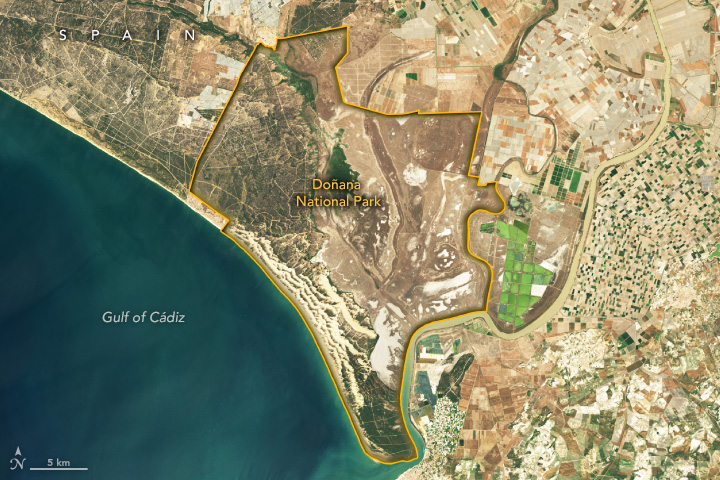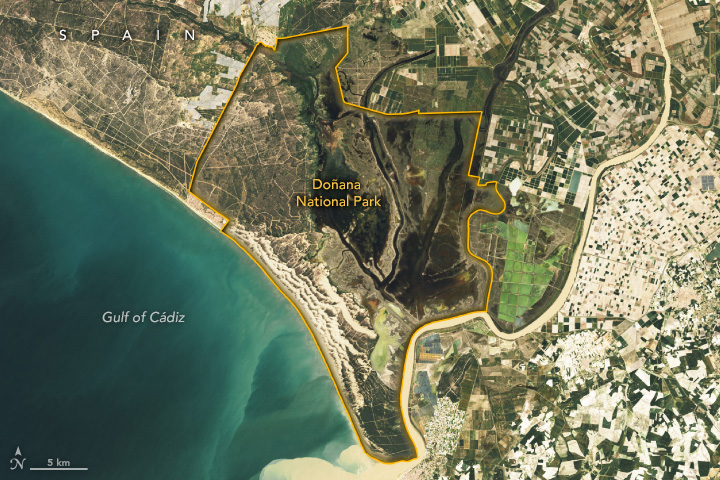

Rain Revives Doñana National Park
Downloads
- donananationalparkoli_20230415_lrg.jpg (2642x1761, JPEG)
- donananationalpark_oli2_20240409_lrg.jpg (2642x1761, JPEG)
Metadata
- Sensor(s):
- Landsat 8 - OLI
- Landsat 9 - OLI-2
- Data Date: April 15, 2023 - April 9, 2024
- Visualization Date: April 24, 2024
Protected wetlands in Spain’s Doñana National Park saw a reprieve from persistent drought in spring 2024. Rainfall in late March helped flood marshes, fill small temporary ponds, and revive vegetation in this unique habitat.
For more than a decade, the area has received below-average levels of rainfall. The situation has become more acute over the past three years, when some of the lowest annual precipitation totals have been recorded. Unusually high temperatures have exacerbated drought conditions throughout the country. January 2024 was Spain’s warmest January on record, with temperatures 2.4 degrees Celsius (4.3 degrees Fahrenheit) higher than average, and the first quarter of 2024 may have been its warmest since records began in 1961.
Heavy rains in late March 2024 brought some relief to Doñana National Park in the Andalusia region. These images compare the area on April 15, 2023 (left), when wetlands were largely dried up, to the same area on April 9, 2024 (right), following a period of rain. They were acquired by the OLI (Operational Land Imager) on the Landsat 8 satellite and the OLI-2 on Landsat 9, respectively. Agricultural fields and arrays of greenhouses surround the protected area, which is designated a UNESCO World Heritage Site and Biosphere Reserve, as well as a Ramsar Wetland of International Importance.
A weather station in the park recorded 145 millimeters (5.7 inches) of rain in March 2024, making it the second wettest March on record. More than 400 millimeters have already fallen during the current water year, defined in this case as running from September 2023 through August 2024. That is more than has fallen in each of the past three full water years, but still below the historical yearly average of more than 500 millimeters.
The western portion of the park contains thousands of small, shallow pools known as Mediterranean temporary ponds that undergo natural cycles of flooding and drought. After the rain, the Doñana Biological Station reported that several of the largest ponds flooded. Marsh areas farther inland also flooded, although some parts remained dry.
Water demands from development outside the protected area are taxing the underlying aquifer and influencing the ecosystem. Increased cultivation of thirsty crops just outside of the park’s boundaries, as well as an adjacent resort town, have drawn groundwater away from the protected wetlands. A 2023 study found that many of the intermittent ponds have been flooding less extensively and for less time over the past few decades, and some have remained dry for at least 10 years.
Wildlife populations have dwindled along with the water in Doñana’s marshes, wetlands, and dunes. According to a Doñana Biological Station report, the decrease in flooding has contributed to declines in breeding waterfowl, amphibians, and fish, as well as butterflies and endangered plants. However, the spring 2024 flooding came in time to spur a growth of vegetation that favors breeding waterfowl such as coots, grebes, and herons, the center noted.
Experts caution that the changes on the surface do not necessarily reflect long-term relief from water shortages. “The rains have partially alleviated the most immediate drought problems, but they do not solve the invisible problem of groundwater overexploitation,” said Javier Bustamante, a researcher at the Doñana Biological Station, in a statement. The overall effect of the rainfall, he added, will become clearer in the coming months.
References
- Doñana Biological Station (2024, February 1) Doñana’s situation in 2023: drought, high temperatures and clear species declines. Accessed April 24, 2024.
- Doñana Biological Station (2024, April 8) Easter rains bring relief to Doñana, but more rainfall is needed this spring. Accessed April 24, 2024.
- Euronews (2024, April 3) Spain on track for hottest first quarter on record: Have heavy rains helped with severe drought? Accessed April 24, 2024.
- NASA Earth Observatory (2023, May 23) Spain Browned by Drought. Accessed April 24, 2024.
- NASA Earth Observatory (2023, June 26) Water Woes in Doñana National Park. Accessed April 24, 2024.
NASA Earth Observatory images by Wanmei Liang, using Landsat data from the U.S. Geological Survey and boundary data from ProtectedPlanet. Story by Lindsey Doermann.
This image record originally appeared on the Earth Observatory. Click here to view the full, original record.